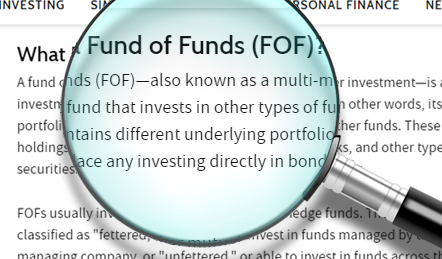
What is a Fund of Funds?*
06.15.2023The fund of funds may be one of the most misunderstood investment products in existence. It is frequently dismissed out of hand simply because it charges a fee – which means fees on fees so it cannot be a good investment, right? Investors with that mindset may be missing out. A fund of funds is neither good nor bad on its face, it is merely an investment access vehicle – a means to an end. Only after careful evaluation should investors determine whether the risks and rewards of exposure to a set of assets warrants the use of the vehicle. In fact it may be the most rational choice, fees and all.
Fund of funds are exactly what the name implies; an aggregation of investment funds into a convenient single fund structure. There are both asset classes and investors for which it is ideal. Without the option of a fund of funds, exposure to certain assets would be out of reach for many investors. I speak from experience, while serving as the Chief Investment Officer for a $3 billion foundation, we identified exposures that were best acquired through this vehicle.
So once an investor has determined the assets to which they’d like exposure, they need to next figure out the best method to obtain that exposure and sometimes it will be a fund of funds. So what asset classes are suited for the fund of funds approach?
Fund of funds tend to work best in private markets which feature four attributes that make the vehicle an ideal option.
- Where there is a high amount of dispersion between the best and worst performing fund managers.
- Where there are many different investment strategies being pursued.
- When there are high minimum investment thresholds to invest in individual funds.
- When investor demand for funds exceeds available fund capacity limiting who gets access.
Private markets tend to be incredibly attractive with high return potential and are highly diversifying to investor portfolios. That is why demand exceeds supply and investment managers can set a high bar for entry. Given these constraints, access to many investment managers are highly network driven, with a small number of ‘haves’ relative to the universe of ‘have nots’. In these markets, historically who you knows matters a lot.
Let’s dive in a bit farther and define the markets where fund of funds work best.
1. High dispersion of returns
In private markets it is often the case that there is significant dispersion between the top quartile and the bottom quartile performers in a universe of managers. In these instances, the reward for selecting your managers well is very high and the penalty for poor manager selection can be equally high. The differences between the best performing managers and the worst can range from a thousand basis points instead of the more typical few basis points found in mutual funds that trade public equities.
2. Investment strategies are widely varied
Private markets are not easily indexed and are composed of investment strategies that are highly differentiated from one another. The private nature of the vehicles allows managers to build portfolios using proprietary investment strategies which is why the strategies are able to truly outperform the market. In the hedge fund space for example, strategies can range from long/short equities, global macro, quantitative, and trend following to name a few. Furthermore, investment strategies will typically span multiple asset classes including equities, fixed income, commodities and currencies. In private equity markets, strategies will range from venture to growth to buyouts. Within each of those categories, further multiple specialties exist. In these types of markets, concentrated portfolios introduce new risks while diversification increases the probability of capturing the market’s outperformance.
3. Lofty investment minimums
The minimum amount that investors must contribute in many of these funds serves to limit access to the smaller investor. With large minimum investment thresholds, it can quickly become difficult to build diversified portfolios. Some highly sought after funds may feature minimum thresholds of $25 million or more. But even assuming much smaller minimums, if ten managers are needed to achieve adequate diversification and complete coverage of the opportunity set, this may still be out of reach. Given these minimums, a fund of funds may be the ideal way to access these vehicles.
4. Capacity constraints
With all that has been covered already, it should not be surprising that more investors seek access than is available. For many of these investment strategies to continue to outperform the market, they must remain appropriately sized and that necessarily creates capacity constraint. Investment managers that have the ability to raise their funds in mere weeks do not typically add many new investors as existing investors hold on to coveted allocations. Investors early to the game or part of the industry have an unfair knowledge advantage. Even when new managers are formed, existing relationships drive access.
Historically, investors in private markets are institutional investors with large portfolios of capital to deploy. These investors are typically foundations, endowments, pension funds, sovereign wealth funds, and increasingly large family offices. The individuals who manage these assets are the keepers of the relationship and frequently can take those relationships with them to new positions. The network feeds upon itself.
In these instances, a fund of funds vehicle can easily navigate the difficulties of entering today or going it alone. Generally, they aggregate capital from smaller portfolios thereby creating the same size footprint of a larger investor. These funds are also typically managed by seasoned investors who have built decades of relationships and rather than serving a single entity are using their talents to serve many.
For a case study on using a fund of funds for venture capital, click here.
In summary, sometimes the question comes down to whether there is a viable vehicle available to gain access to an investment class. For markets that feature high returns, demand that exceeds supply and an infinite number of investment strategies, investors that seek to go it alone should have an established reputation, large portfolio of assets and a team of professionals if they hope to avoid the underperformance penalty (while paying high fee rates) of poor selection. If the cost of going it alone is too high, then consider a fund of funds where a professionally built portfolio very much pays for itself.
In a future post we will delve further into use of fund of funds in venture capital, specifically looking at the strategic case for a venture capital allocation. Corporate interest in startups continues to increase and diversified exposure to the funders of these startups can be an ideal tool in the innovation toolkit.
*Author’s note: Fund of funds in this writing does not refer to government created entities which feature a single limited partner (the government using public funds) and are typically created to foster economic development and not primarily for investment return.


